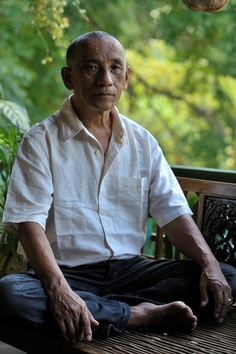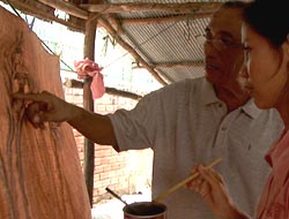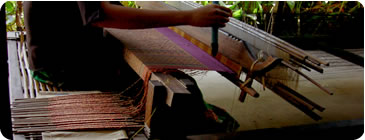
Region: Cambodia
Category: Cultural heritage
"I will never forget the faces of the grandmothers when I delivered the [silkworm] eggs or the way they drew the thread so efficiently, just how they used to -- their fingers knew exactly what to do."
Kikuo Morimoto was born in Kyoto in 1948. In 1975, after a five-year apprenticeship, he started his career in the Japanese textile technique of painting and dyeing kimono fabric known as yuzen. In 1980 he made his first visit to Bangkok, where he discovered Khmer traditional silk ikat textiles at the National Museum.
In 1983, Morimoto moved to Thailand to serve as a volunteer in refugee camps in Northeast Thailand. He started a hand-weaving project in a village in Roi Et province in 1984. After leaving the project, he started to examine natural dyeing practices in the region. In 1988, he opened Bai Mai, a shop in Bangkok selling handspun silk dyed with natural dyes. In 1990, as a collaborating researcher for The Textile Museum (Washington, DC), he compiled a report entitled "Traditional Dyeing Methods in Northeast Thailand". From 1992 to 1995, he taught natural dyeing in the King Mongkut Institute of Technology (Bangkok).
In 1996, Morimoto founded IKTT (the Institute for Khmer Traditional Textiles) in a suburb of Phnom Penh to tackle revival and activation of tradition textiles in Cambodia ("neither art nor hope can exist on an empty stomach"). In 2000, he moved the Institute to Siem Reap, where he set up a workshop for weaving and dyeing with the goal of enabling elder craftspeople to hand on their skills to younger generations. In 2002, he purchased five hectares of land north of Angkor to begin his next project, "Wisdom from the Forest". (Challenge: Reforestation in Cambodia is a more arduous process than elsewhere, involving the added step of removing land mines.) In 2003, IKTT held an exhibition and seminar, "Hol, The Art of Cambodian Textiles," in collaboration with the Center for Khmer Studies in Siem Reap. In 2004, Morimoto received the Rolex Award for Enterprise. In 2007, he had the honor to be granted a royal audience with King Sihamoni at the Royal Palace in Phnom Penh.
Motivation of his Project:
The almost complete disappearance of traditional skills and the mass selling-off of museum–quality treasures during the war have meant that the younger generation knows nothing of this important part of the nation’s cultural past.
Key achievements of his Project:
Kikuo Morimoto is making major progress in his project to re-establish local production of traditional textiles to help revitalize rural Cambodia. Morimoto is already providing ways to earn a living to more than 300 individuals in Cambodia.
Expectation:
He hopes that his example will inspire the youth of Asia’s richest nation as much as it will help those of Cambodia, the continent’s poorest.
My track record is not enough to say that anything has changed in the last 30 years; I believe that there is a lack of research in this field. However, in 1995 at the time when I started my organization, Cambodia was in the middle of a civil war during which the textile traditions were about to fully disappear. It took the industry about 10 years to revive and more than 20 years to become a substantial source of income for the Cambodian population again. Today, several years later both stability and economic growth is taking place in Cambodia and the population is once again interested in cultural traditions and their reality.
Social Entrepreneurship serves as an important mechanism for organizing problem solving in today’s society. According to you, what are the fundamental differences between social and for-profit founders? What were your motivations to dedicate your life to saving Cambodia’s silk industry?
In 1995, the population, including myself, did our best to survive the civil war. In that period, society continuously shifted from periods of confusion to periods of growth.
In general, I believe that business owners focus on periods of growth and priorities the subjects, which will benefit the owners. Whereas, social entrepreneurs like myself don’t focus on benefits to our selves or the project, but on social significance and changes. I think this is a big difference and the diverse priorities will lead business in different directions.
When I first visited Cambodia in 1980, people were living in refugee camps. These people were in an extremely harsh environment and it highly motivated me to meet these people. It was one thing that triggered me to start my project in Cambodia. Also, I knew that before the war the traditional textile weaving had been great in the Cambodian village and I wanted to go back into this time of great traditions.
You created IKTT (the Institute for Khmer Traditional Textiles) in 1996 to re-establish local production of traditional textiles and to help revitalize rural Cambodia. This project is already providing an income to hundreds of individuals in Cambodia. How has it evolved over time? What were the biggest challenges you faced in the last 16 years?
I worked on the challenge to restore the fabric of tradition while activating it. I have given people different responsibilities. Firstly, I looked for people with experience in the field that could pass on the information to the next generations. Then, over time, I managed to hire people and as such provide work and an income to people in poverty. However, it was only possible over a long period of time, this is not something one can do in a hurry.
| What was your greatest success and failure as a social entrepreneur? I think my biggest success was to improve people’s lives and villages, while supporting traditional textile production in its natural environment. However, the overall situation in Cambodia is still not perfect and some people are still living in poverty and cannot be sustained, which is a failure. A lack of capital is always a big issue for entrepreneurs, especially in developing countries. How do you make your organization financially sustainable? Basically, I thought it could operate without relying on donations. However, since I was never financially blessed, it |
In order to revive traditional weaving and provide profitable work to hundreds of people making heritage-class textiles, you have organized projects to replant trees in Cambodia. Reforestation in Cambodia is a more arduous process than elsewhere due to the land mines. How did you overcome the difficulties and finally succeed in it?
I noticed that the rich natural resources of Cambodia have nurtured the textile tradition. To that end, forests play a critical role for my everyday business activities, which is why we have chosen to support the reforestation in Cambodia. However, regeneration of the forest is a time-consuming task that must be continued for many generations.
What are other obstacles social entrepreneurs are facing in Cambodia? What advice would you give to social entrepreneurs in order to overcome these obstacles?
In order to make your dreams come true you must have strong beliefs in what you are doing and align your knowledge and experience. I think it is important to have a good understanding of the field and good cooperation partners in the area you are active in, particularly in a country such as Cambodia.
| According to you, what is the fundamental difference between social entrepreneurs from developed and developing countries? There are so many differences, but the main ones are a difference in the environment, the specific support conditions for social entrepreneurs and structural basis to start a company in general. |
People believe that the work of social entrepreneurs establish and strengthens emerging economies. What is you opinion on this? How has the political system in your country affected your project?
As a social entrepreneur, I believe that the field is very wide and that action is done in different fields respectively. However, the important thing is that businesses are running, contributing to the sustainable development of the society and the economy, in general.
You have more than 400 employees at your studio - all earning much more than the average income in the country. What is your goal for the next 10 years?
My goal is to provide the highest quality silk in the world. I have seen old, splendid pieces of Khmer fabric. People have digressed since then. To bring back those skills is not going to be easy. A hundred years ago, Cambodians used to make magnificent fabrics. Cambodian ikat [fabric made from yarns that have been tie-dyed before weaving] is collected in famous museums around the world; they are in the hands of famous collectors. I have seen [the fabrics]. If we can restore and recreate a world that has been decimated by civil war, there are people who would most certainly want these fabrics. And this will allow people to put food on the table. Our first mission is to make the best ikat in the world. For this, there is no compromise.
What advise would you give to up-coming social entrepreneurs?
The mind is the limit. I recommend that you push yourself to achieve societal change in belief, knowledge and experience. In addition, don’t be afraid of taking risks. Please, take the first step!
Is there anything else you would like to add?
Where there is reality there is also a dream. In order to come up with this idea, don’t think about your restrictions, but your possibilities. It is important that you aim for the top. If you stop in the middle, it might be a failure, but as long as you continue, you will never fail.
To learn more about IKKT and the work of Kikuo Morimoto, take a look at the following video. Make sure to also watch parts 2 and 3.



 RSS Feed
RSS Feed
